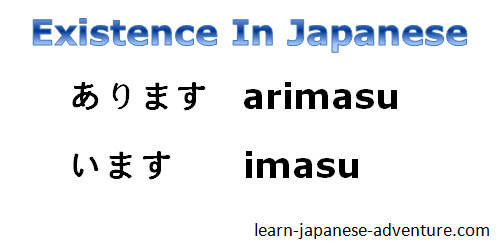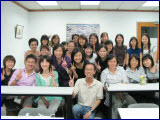- Home
- Basic Lessons
- arimasu and imasu
Using arimasu and imasu
to Express Existence in Japanese -
Free Japanese Lessons: 7
arimasu and imasu are 2 Japanese verbs used to express existence of thing and people/animal respectively.

あります (arimasu) is used when what is present does not move by itself, like thing or plant.
On the other hand います (imasu) is used when what is present moves by himself/itself, like people or animal.
The simplest form of sentence to express existence will be...
Noun が あります
Noun ga arimasu
Meaning: There is a Noun. (for inanimate thing including plant)
Noun が います
Noun ga imasu
Meaning: There is a Noun. (for people and animal)
The thing, people and animal in the above sentence structures are treated as subjects and hence marked with the particle が (ga). Let's use some examples to demonstrate the above format...
- つくえがあります。
tsukue ga arimasu
Meaning: There is a desk. - きがあります。
ki ga arimasu
Meaning: There is a tree.
- おとこのこがいます。
otoko noko ga imasu
Meaning: There is a boy. - ねこがいます。
neko ga imasu
Meaning: There is a cat.
Use Particle に (ni) for the Place of Existence
To indicate the place where the subject is present, use the particle に (ni).
Place に Noun があります
Place ni Noun ga arimasu
Meaning: There is a Noun in/at the Place. (for inanimate thing including plant)
Place に Noun がいます
Place ni Noun ga imasu
Meaning: There is a Noun in/at the Place. (for people and animal)
Using some examples to show the above format...
- へやにつくえがあります。
heya ni tsukue ga arimasu
Meaning: There is a desk in the room. - こうえんにきがあります。
kouen ni ki ga arimasu
Meaning: There is a tree in the park.
- きょうしつにせんせいがいます。
kyoushitsu ni sensei ga imasu
Meaning: Teacher is in the classroom. - キッチンにねこがいます。
kicchin ni neko ga imasu
Meaning: A cat is in the kitchen.
Thing/Place/Person の Position
In lesson 3 on Japanese noun part 2 I have mentioned that you can use one noun to modify another noun. One of the meanings is to describe the location.
I will give more examples on the above so that we can use the location in the existence sentence structure.
| Kanji | Hiragana | Romaji | Meaning | |
| 1. | 上 | うえ | ue | on/upon |
| 2. | 下 | した | shita | below/under |
| 3. | 前 | まえ | mae | in front of |
| 4. | 後ろ | うしろ | ushiro | behind/back |
| 5. | 右 | みぎ | migi | right |
| 6. | 左 | ひだり | hidari | left |
| 7. | 中 | なか | naka | inside |
| 8. | 外 | そと | soto | outside |
| 9. | 側/傍 | そば | soba | beside/near |
| 10. | 横 | よこ | yoko | next to (left or right) |
| 11. | 隣 | となり | tonari | next to (left or right, but limited to same category) |
With the above location words, you can describe the place in the existence sentence more specifically. For example...
- つくえのうえにりんごがあります。
tsukue no ue ni ringo ga arimasu
Meaning: There is an apple on the desk. - こうえんのうしろにがっこうがあります。
kouen no ushiro ni gakkou ga arimasu
Meaning: There is a school behind the park. - いすのしたにねこがいます。
isu no shita ni neko ga imasu
Meaning: There is a cat under the chair.
How to Ask Who or What Exists in the Place?
To ask a question, you need to use some question words like だれ (dare) for people and なに (nani) for animal and thing. Look at the following format...
Place に だれ がいますか
Place ni dare ga imasuka
Meaning: Who is in/at the Place? (existence of people)
Place に なに がいますか
Place ni nani ga imasuka
Meaning: What is in/at the Place? (existence of animal)
Place に なに がありますか
Place ni nani ga arimasuka
Meaning: What is in/at the Place? (existence of thing)
To show with some examples...
- Question: かいぎしつにだれがいますか。 (kaigishitsu ni dare ga imasu ka)
Answer: かいぎしつにたなかさんがいます。 (kaigishitsu ni tanaka san ga imasu)
Meaning:
Question: Who is in the meeting room?
Answer: Mr Tanaka is in the meeting room.
- Question: いすのしたになにがいますか。 (isu no shita ni nani ga imasu ka)
Answer: いすのしたにねこがいます。 (isu no shita ni neko ga imasu)
Meaning:
Question: What is below the chair?
Answer: A cat is below the chair.
- Question: はこのなかになにがありますか。 (hako no naka ni nani ga arimasuka)
Answer: はこのなかにりんごがあります。 (hako no naka ni ringo ga arimasu)
Meaning:
Question: What is inside the box?
Answer: An apple is inside the box.
How to Answer Yes/No Questions?
Sometimes the question is in such a format that you need to answer yes or no, like the following...
Question: Place に Subject がいますか/ありますか
Answer: はい、 Subject がいます/あります (positive answer)
Answer: いいえ、 Subject がはいません/ありません (negative answer)
Generally, particle は is used for negative sentences.
Negative form of います → いません (imasen)
Negative form of あります → ありません (arimasen)
Using some examples...
- Question: こうえんにはながありますか。 (kouen ni hana ga arimasuka)
Answer: はい、はながあります。 (hai, hana ga arimasu)
Answer: いいえ、はなはありません。 (iie, hana wa arimasen)
Meaning:
Question: Is there flower in the park?
Answer: Yes, there is flower.
Answer: No, there is no flower.
How to Say Nothing/No One Exists?
When there is nothing or no one exists in a place, use the following format...
Place には だれも いません
Place niwa dare mo imasen
Meaning: No one exists in/at the Place. (people)
Place には なにも いません
Place niwa nani mo imasen
Meaning: Nothing exists in/at the Place. (animal)
Place には なにも ありません
Place niwa nani mo arimasen
Meaning: Nothing exists in/at the Place. (thing)
Using Particle は (wa) as Topic Marker in the Existence Sentence
When the speaker is talking about something or someone both he and the listener know about, you should use the following sentence pattern...
Person は Place にいます
Person wa Place ni imasu
Meaning: Person is in the Place.
Thing は Place にあります
Thing wa Place ni arimasu
Meaning: Thing is in the Place.
And when you want to ask where is the place for the above sentence pattern, use the question word どこ...
Person は どこ にいますか
Person wa doko ni imasuka
Meaning: Where is the Person?
Thing は どこ にありますか
Thing wa doko ni arimasuka
Meaning: Where is the thing?
Using some examples to show the above sentence patterns...
- Question: やまださんはどこにいますか。 (yamada san wa doko ni imaska)
Answer: やまださんはきょうしつにいます。 (yamada san wa kyoushitsu ni imasu)
Meaning:
Question: Where is Mr Yamada?
Answer: Mr Yamada is in the classroom.
- Question: ほんはどこにありますか。 (hon wa doko ni arimasuka)
Answer: ほんはつくえのうえにあります。 (hon wa tsukue no ue ni arimasu)
Meaning:
Question: Where is the book?
Answer: The book is on the desk.
Black Friday Sale! Get 55% OFF on Basic, Premium & Premium PLUS plans! Ends on 29 Nov 2025
The link above is an affiliate link, which means that I would earn a commission (at no extra cost to you) if you do end up purchasing the related learning course.
Previous - Lesson 6: Japanese Adjectives Part 2








Facebook Comments
Don’t see the comments box? Log in to your Facebook account, give Facebook consent, then return to this page and refresh it.